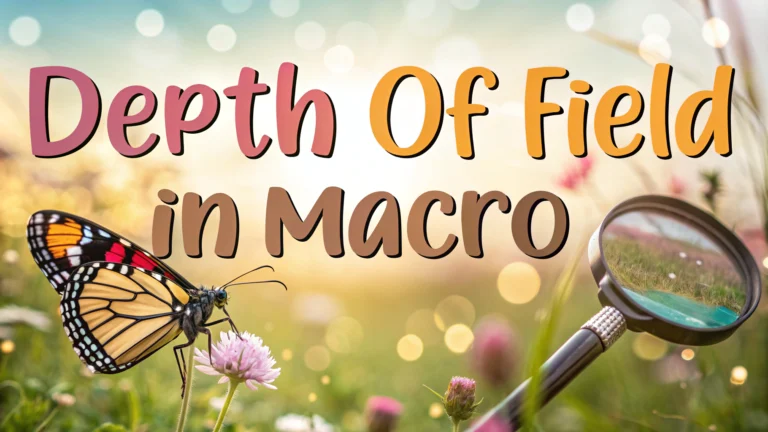Depth of field (DoF) can make or break a macro photograph, as it determines which parts of your subject appear sharp and which parts fade into a blur.
In macro photography, depth of field is typically very shallow – often just a few millimeters.
Key Factors Affecting Depth of Field
- Aperture (f-number)
- Focusing distance
- Focal length
- Sensor size
Working with Limited Depth of Field
Using smaller apertures (higher f-numbers like f/16 or f/22) increases depth of field, but also requires more light or slower shutter speeds.
Focus stacking combines multiple images taken at different focus points to create one fully sharp image.
Practical Tips for Managing DoF
- Position your camera parallel to the subject’s plane to maximize sharpness
- Use manual focus for precise control
- Start with f/8 as a baseline aperture
- Consider using a focusing rail for precise adjustments
- Take test shots to check your depth of field
Recommended Equipment
- Macro lens with manual focus capability
- Sturdy tripod
- Remote shutter release
- Focus stacking software (like Helicon Focus or Zerene Stacker)
The choice between deep or shallow depth of field depends on your artistic vision and subject matter.
Quick DoF Reference Table
| Aperture | DoF at 1:1 Magnification |
|---|---|
| f/2.8 | 0.2-0.3mm |
| f/8 | 0.5-0.7mm |
| f/16 | 1.0-1.2mm |
Common Mistakes to Avoid
- Using too wide an aperture for complex subjects
- Ignoring subject angle relative to sensor
- Not accounting for diffraction at very small apertures
- Moving during long exposures
Understanding and controlling depth of field takes practice, but mastering it will significantly improve your macro photography.
Advanced Techniques
When basic depth of field control isn’t sufficient, several advanced techniques can enhance your macro photography.
Focus Bracketing
Many modern cameras offer automated focus bracketing, capturing a series of images at slightly different focus points. This feature streamlines the focus stacking workflow.
Light Management
- Ring lights provide even illumination at close distances
- Diffused flash helps maintain faster shutter speeds at small apertures
- LED continuous lighting aids precise focus assessment
Environmental Considerations
Wind, vibration, and subject movement become critical factors when working with limited depth of field.
- Use wind breaks for outdoor shoots
- Consider shooting during calmer times of day
- Enable image stabilization when appropriate
Conclusion
Mastering depth of field in macro photography requires understanding technical principles, using appropriate equipment, and developing practical shooting techniques. Success comes from balancing creative vision with technical constraints while maintaining attention to detail.
Regular practice and experimentation with different subjects and techniques will help develop intuition for managing depth of field effectively in various macro photography scenarios.
Depth of Field Tips for Macro Photos
Getting sharp macro photos requires understanding how depth of field works at close focusing distances, where even tiny movements can throw your subject out of focus.
Most Common Questions About Macro Depth of Field
- What aperture should I use for macro photography?
For most macro subjects, start with f/8 to f/11 to balance depth of field with image quality, as smaller apertures can introduce diffraction.
- How do I get more depth of field in macro shots?
Use focus stacking techniques by taking multiple photos at different focus points and combining them in post-processing software like Photoshop or Helicon Focus.
- Why are my macro photos always partially blurry?
At high magnifications, depth of field becomes extremely shallow – often just millimeters deep – requiring precise focusing and possibly focus stacking techniques.
- Does sensor size affect macro depth of field?
Smaller sensors provide slightly more depth of field at the same aperture and magnification ratio.
- What’s the best focusing technique for macro?
Use manual focus and move your camera back and forth slightly to find the perfect focus point, rather than turning the focus ring.
- Should I use image stabilization for macro?
Turn off image stabilization when using a tripod for macro work, as it can introduce subtle movement.
- What lighting helps with macro depth of field?
Using a flash or continuous lighting allows you to stop down to smaller apertures while maintaining fast enough shutter speeds to prevent blur.
- How does magnification ratio affect depth of field?
Higher magnification ratios result in significantly decreased depth of field – at 1:1 magnification, you might have less than 1mm of focus depth.
- What’s the relationship between working distance and depth of field?
Longer working distances (using longer macro lenses) provide slightly more depth of field than shorter working distances at the same magnification.
- How can I preview depth of field for macro shots?
Use your camera’s depth-of-field preview button while looking through the viewfinder, or use live view with exposure simulation enabled.
Quick Tips for Managing Macro Depth of Field
- Use a tripod whenever possible to maintain precise focus
- Position your subject parallel to the sensor for maximum sharpness
- Consider using focus rails for precise adjustments
- Start with wider apertures to compose and focus, then stop down
- Take multiple shots at different apertures to ensure you get the depth of field you need
Recommended Equipment
- Sturdy tripod with macro focusing rail
- Remote shutter release or self-timer
- Macro flash or LED lighting system
- Focus stacking software











